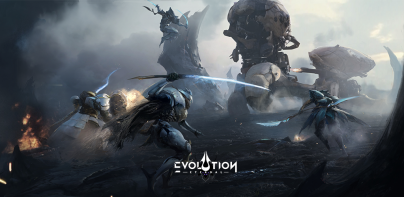


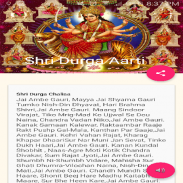
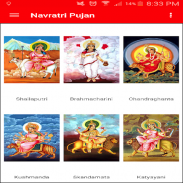
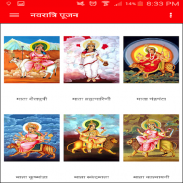
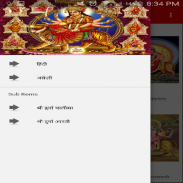
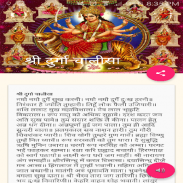
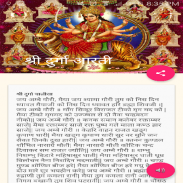

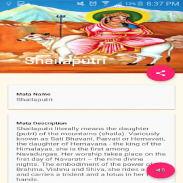
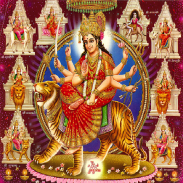
Navratri Pujan Vidhi Vidhan
AndroidDev.401
وصف لـNavratri Pujan Vidhi Vidhan
Navratri is a Hindu festival of worship and dance. The word Navratri literally means nine nights in Sanskrit; Nava meaning Nine and Ratri meaning nights. During these nine nights and ten days, nine forms of shakti/Devi i.e. female divinity are worshipped.
The nine night’s festival of Navratri begins on the first day of Ashwina of the bright fortnight. The festival comes to an end on the tenth day of Vjay Dashmi or Dussehra, when the idols of the Goddess Shakti are immersed in the river. Dussehra, meaning ‘ten days’, becomes dasara in popular parlance. The Navratri festival or ‘nine day festival’ becomes ‘ten day festival’ with the addition of the last day, Vijayadashami which is its culmination. On all these ten days, the various forms of Mother Mahisasura-mardini (Durga) are worshipped with fervour and devotion.
The nine nights are dedicated to the three main goddesses of Hinduism – Parvati, Lakshmi and Saraswati. Navratri is separated into sets of three days. First three days of Navratri are dedicated to Goddess Durga, the Goddess of power and energy. Next three days of Navratri are dedicated to Goddess Lakshmi, the Goddess of wealth and prosperity. The final three days belong to Goddess Saraswati who is worshipped to acquire the spiritual knowledge.
Goddess Durga is also worshipped under nine different names for the nine days in Navratri. Every day, she assumes a new character, a new look and a new duty. These nine forms of manifestation are Shailaputri, Brahmachartini, Chandraghanta, Kushmanda, Skandamaata, Kaatyayani, Kaalratri, Mahagauri and Siddhidaatri. For the initial six days Puja celebrations are limited to home. The celebrations acquire a festive form since the seventh day when the festivities of Navratri surround the atmosphere.
Navratri هو مهرجان هندوسي العبادة والرقص. كلمة Navratri تعني حرفيا تسع ليال في اللغة السنسكريتية. نافا معنى تسعة وRatri يعني ليال. خلال هذه الليالي تسعة وعشرة أيام، تسعة أشكال شاكتي / تعبد ديفي أي الألوهية الإناث.
مهرجان ليلة تسعة من Navratri يبدأ في اليوم الأول من Ashwina من أسبوعين مشرق. المهرجان إلى نهايته في اليوم العاشر من Vjay Dashmi أو Dussehra، عندما مغمورة أصنام آلهة شاكتي في النهر. Dussehra، وهذا يعني "عشرة أيام"، ويصبح dasara في اللغة الدارجة. مهرجان Navratri أو "تسعة أيام المهرجان" يصبح "عشرة أيام المهرجان" مع إضافة في اليوم الأخير، Vijayadashami وهو ذروتها. على كل هذه الأيام العشر، ويعبد مختلف أشكال الأم Mahisasura-مارديني (دورغا) مع الحماس والتفاني.
هي مكرسة لتسع ليال للآلهة الثلاثة الرئيسية للهندوسية - بارفاتي، لاكشمي، وساراسواتي. يتم فصل Navratri في مجموعات من ثلاثة أيام. ملتزمون أول ثلاثة أيام من Navratri لآلهة دورغا، إلهة الكهرباء والطاقة. ملتزمون المقبلة ثلاثة أيام من Navratri إلى إلهة لاكشمي، إلهة الثروة والرخاء. الأيام الثلاثة الأخيرة تنتمي إلى آلهة ساراسواتي الذي يعبد لاكتساب المعرفة الروحية.
يعبد آلهة دورغا أيضا تحت تسعة أسماء مختلفة لتسعة أيام في Navratri. كل يوم، وقالت انها تفترض شخصية جديدة، نظرة جديدة وواجب جديد. هذه الأشكال تسعة من مظاهر هي Shailaputri، Brahmachartini، Chandraghanta، Kushmanda، Skandamaata، Kaatyayani، Kaalratri، Mahagauri وSiddhidaatri. لستة أيام الأولية والاحتفالات بوجا تقتصر على المنزل. الاحتفالات تكتسب شكل احتفالي منذ اليوم السابع عندما احتفالات Navratri تحيط الغلاف الجوي.









